It looks like you're using an Ad Blocker.
Please white-list or disable AboveTopSecret.com in your ad-blocking tool.
Thank you.
Some features of ATS will be disabled while you continue to use an ad-blocker.
share:
The linguistic connections of Runes and Phoenician script probably stem from Neolithic Vinca, there is research that suggests each has their roots in
Vinca and are ways of depicting astronomy, probably for practical purpose such as farming.
From such routes and communities, there would be trade, and migration, taking their cultures to new lands.
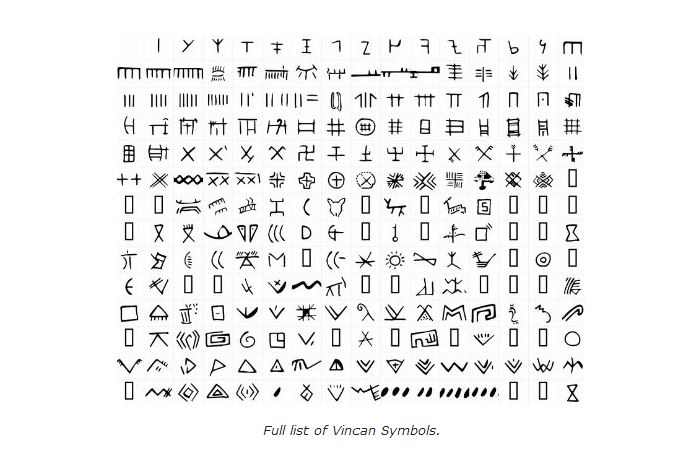
www.ancient-wisdom.co.uk...
From such routes and communities, there would be trade, and migration, taking their cultures to new lands.

www.ancient-wisdom.co.uk...
Similarities to Other Cultures.
What we have then is the record of a civilisation that flourished in Europe between 6,000 and 3,500 BC and which appears to have enjoyed a long period of uninterrupted and peaceful living. The 'Old European' Vinca pottery, artefacts and writing all show an immediately noticeable similarity to what was originally thought to be an earlier Ubaid Sumerian influence from the middle east. In addition, the Cycladian/Cretan cultures are suspected of having close close artistic and possibly religious connections with the Vinca. Both of these cultures appeared following the demise of the Old European Heartland, perhaps not so coincidentally, at the same time as several other important civilisations (Egyptian, Indus Valley, Western European, Maltese Etc) appeared in the prehistoric record.
Several eminent archaeologists of the time (such as Childe, Hood, Vlassa, Maccay), were convinced that the Vinca had somehow been influenced or 'cradled into being' by the mistaken belief at the time that the Sumerians were the 'Mother race'. However, much to everyone surprise, more recent discoveries of earlier Vinca settlements have shown quite clearly that events must have occurred the other way round as the Old European settlements, along with writing, pottery, metallurgy and 'Ubaid' style art, date to a thousand years before the first Sumerian fingerprint, suggesting remarkably that it was actually a Western European culture that influenced Sumerian development.
The Vinca sculptures (above) show strong symbolic similarities to later Cretan 'Mother-Goddess' figurines and what might be the earliest representation of an 'Omphalos'.
Other similarities with cultures that followed the Vinca's demise have been noted such as the rise of the so-called Cycladic and Cretan cultures, where the new settlers arrived around 3,200 BC. with identical motifs such as the snake, intertwined with the bird goddess motif, the bee and the butterfly, with the distinctive motif of the double axe, are found both in 'Old Europe' and Crete. But the best evidence is in the writing of Old Europe and the 'Linear A' script of Crete, which are to all intents and purposes identical.
a reply to: theabsolutetruth
Hm, I have an ancient tome that tries to claim the Phoenikians directly influenced the Runic alphabet, but the evidence is scarce. None of their alphabet symbols match the Runes. The only two (n and t) that look like Runes would actually correspond to our s and g, if they were copied.
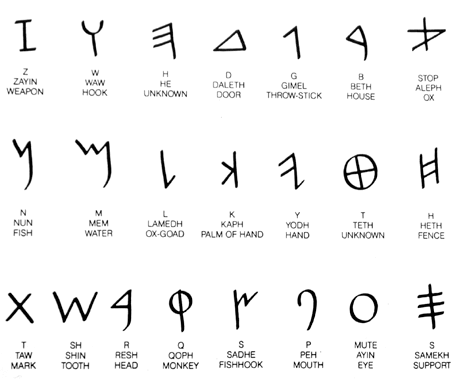
Then there is the glaring fact that there are more sounds in the gamla futhark, and the Phoenikians didnt use vowels!
Hm, I have an ancient tome that tries to claim the Phoenikians directly influenced the Runic alphabet, but the evidence is scarce. None of their alphabet symbols match the Runes. The only two (n and t) that look like Runes would actually correspond to our s and g, if they were copied.

Then there is the glaring fact that there are more sounds in the gamla futhark, and the Phoenikians didnt use vowels!
a reply to: Ridhya
There is theory that they both evolved from Vinca, and also that runes evolved from Phoenician but looking at it closer, it is more likely evolved from Vinca.
There are theories that Vinca is the oldest civilization and form of writing, predating Mesopotamia /Sumeria.
There are direct matches for Runes /Vinca.
IMO it is most viable.
leejohnbarnes.blogspot.co.uk...
There is theory that they both evolved from Vinca, and also that runes evolved from Phoenician but looking at it closer, it is more likely evolved from Vinca.
There are theories that Vinca is the oldest civilization and form of writing, predating Mesopotamia /Sumeria.
There are direct matches for Runes /Vinca.
IMO it is most viable.
Is the Danube Valley Civilization script the oldest writing in the world?
The Danube Valley civilization is one of the oldest civilizations known in Europe. It existed from between 5,500 and 3,500 BC in the Balkans and covered a vast area, in what is now Northern Greece to Slovakia (South to North), and Croatia to Romania (West to East).
During the height of the Danube Valley civilization, it played an important role in south-eastern Europe through the development of copper tools, a writing system, advanced architecture, including two storey houses, and the construction of furniture, such as chairs and tables, all of which occurred while most of Europe was in the middle of the Stone Age. They developed skills such as spinning, weaving, leather processing, clothes manufacturing, and manipulated wood, clay and stone and they invented the wheel. They had an economic, religious and social structure.
One of the more intriguing and hotly debated aspects of the Danube Valley civilization is their supposed written language. While some archaeologists have maintained that the ‘writing’ is actually just a series of geometric figures and symbols, others have maintained that it has the features of a true writing system. If this theory is correct, it would make the script the oldest written language ever found, predating the Sumerian writings in Mesopotamia, and possibly even the Dispilio Tablet, which has been dated 5260 BC.
Danube Valley Civilization Artefacts
Danube Valley Civilization Artifacts (image source)
Harald Haarmann, a German linguistic and cultural scientist, currently vice-president of the Institute of Archaeomythology, and leading specialist in ancient scripts and ancient languages, firmly supports the view that the Danube script is the oldest writing in the world. The tablets that were found are dated to 5,500 BC, and the glyphs on the tablets, according to Haarmann, are a form of language yet to be deciphered. The symbols, which are also called Vinca symbols, have been found in multiple archaeological sites throughout the Danube Valley areas, inscribed on pottery, figurines, spindles and other clay artifacts.
The Vinca Symbols
The Vinca Symbols (Source: Wikipedia)
Danube Valley Civilisation ArtefactThe implications are huge. It could mean that the Danube Valley Civilization predates all other known civilizations today. Evidence also comes from thousands of artifacts that have been found, such as the odd-looking figure displayed on the left. However, the majority of Mesopotamian scholars reject Haarmann’s proposal, suggesting that the symbols on the tablets are just decoration. This is despite the fact that there are approximately 700 different characters, around the same number of symbols used in Egyptian hieroglyphs. Other scholars even suggested that the Danube Civilization must have copied signs and symbols from the Mesopotamian civilizations, despite the fact that some of the Danube tablets have been found to be older that the Mesopotamian ones.
It appears that this is another case of a theory based on solid research being outright rejected without appropriate consideration. Could this be because it conflicts with the accepted view of which nation holds claim to the ‘first civilization’? At the very least, Haarmann’s proposal deserves further research and serious analysis in order to confirm whether this is indeed the oldest known written language in the world.
- See more at: www.ancient-origins.net...
leejohnbarnes.blogspot.co.uk...
VINCA SCRIPT IS 6000 YEARS OLD.
It is the oldest written language in the world and subverts the entire established thesis on the evlution of language.
The Proto-Sinaitic script was in use from ca. 1500 BC in the Sinai and the Levant, probably by early West Semitic speakers. In Canaan it developed into the Proto-Canaanite alphabet from ca. 1400 BC, adapted to writing a Canaanite (Northwest Semitic) language.
The Phoenician alphabet seamlessly continues the Proto-Canaanite alphabet, by convention called Phoenician from the mid 11th century, where it is first attested on inscribed bronze arrowheads.[4] Phoenician became the widespread form of Proto-Canaanite; previously, the script had been restricted to recording only Canaanite languages.
Phoenician differed in only letterform and time period from the Proto-Canaanite script, so it is therefore difficult to attest a specific beginning of the alphabet. However, the oldest known inscription of Phoenician is known as the Ahiram epitaph, and is engraved on the sarcophagus of King Ahiram (circa 1200 BC).
en.wikipedia.org...
So the earliest Phoenician script is dated to 1200 BC.
SO VINCA SCRIPT - the precurser of Phoenician - IS 3000 YEARS OLDER THAN PHOENICIAN.
a reply to: theabsolutetruth
Again, there are only 3 Runes in the Vinca alphabet, and 2 that are similar. Closest argument ive ever seen was descent from latin/greek alphabets. Realistically it's probably influenced from multiple origins. The Eddas state that Odin brought the Runes, and that he came from Turkey/Asia.
A lot of that vinca looks like it evolved from pictograms, similar to Sumerian writing... common origin, I would think?
Again, there are only 3 Runes in the Vinca alphabet, and 2 that are similar. Closest argument ive ever seen was descent from latin/greek alphabets. Realistically it's probably influenced from multiple origins. The Eddas state that Odin brought the Runes, and that he came from Turkey/Asia.
A lot of that vinca looks like it evolved from pictograms, similar to Sumerian writing... common origin, I would think?
a reply to: Ridhya
Vinca predates Sumerian. There are theories of it being the origin of many writing systems.
My opinion is that Vinca is probably the origin of Runes,Mesopotamian, Latin, Greek, Semitic etc.
Looks like there are more than a few similar characters in Vinca and Runes and many with slight variations.
en.wikipedia.org...
en.wikipedia.org...
nsd.007.free.fr...
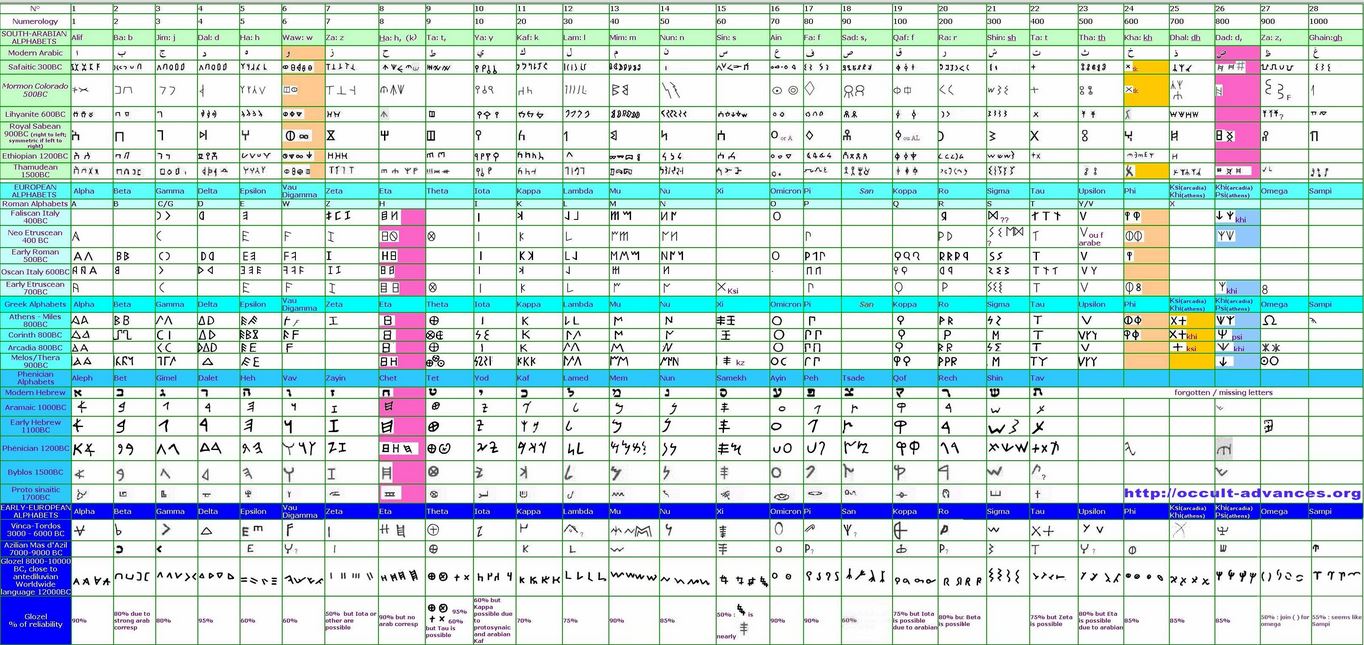
ysaynocafe.com...
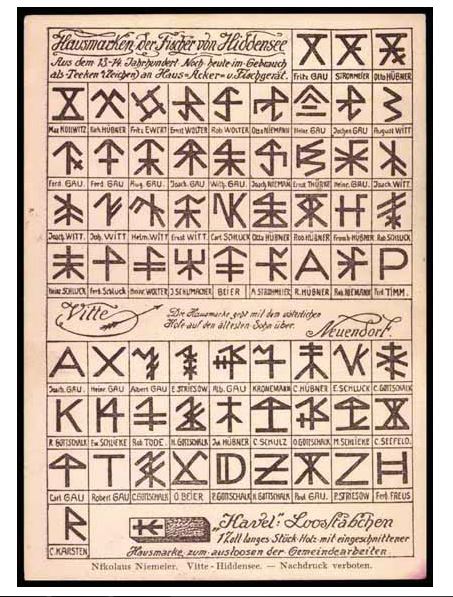
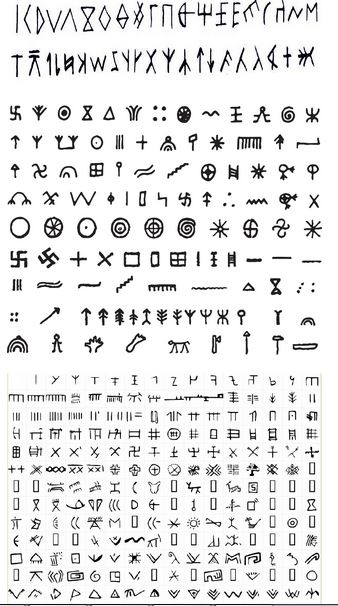
Vinca predates Sumerian. There are theories of it being the origin of many writing systems.
My opinion is that Vinca is probably the origin of Runes,Mesopotamian, Latin, Greek, Semitic etc.
Looks like there are more than a few similar characters in Vinca and Runes and many with slight variations.
en.wikipedia.org...
Neolithic writing
By definition, the modern practice of history begins with written records. Evidence of human culture without writing is the realm of prehistory. The Dispilio Tablet (Greece) and Tărtăria tablets (Romania), which have been carbon dated to the 6th millennium BC, are recent discoveries of the earliest known neolithic writings.
en.wikipedia.org...
The importance of these findings lies in the fact that the bulk of the Vinča symbols was created in the period between 4500 and 4000 BC, with the ones on the Tărtăria clay tablets even dating back to around 5300 BC.[2] This means that the Vinča finds predate the proto-Sumerian pictographic script from Uruk (modern Iraq), which is usually considered as the oldest known script, by more than a thousand years. Analyses of the symbols showed that they have little similarity with Near Eastern writing, leading to the view that these symbols and the Sumerian script probably arose independently. Although a large number of symbols are known, most artifacts contain so few symbols that they are very unlikely to represent a complete text. Possibly the only exception is the Sitovo inscription in Bulgaria, the dating of which is disputed; regardless, even that inscription has only around 50 symbols. It is unknown which language used the symbols, or indeed whether they stand for a language in the first place.
nsd.007.free.fr...

ysaynocafe.com...
In her book Plato Prehistorian: 10,000 to 5000 B.C. Myth, Religion, Archaeology, the author Mary Settegast claims to show evidence of pre-runic scriptures not only in Bronze Age rock carvings, but as far back as in Magdalenian cave paintings dating as far back as at least 17 000 – 12 000 years ago. And indeed, just looking at Scandinavian Bronze Age rock carvings, reveals that there are runic symbols appearing over and over again. Alongside the usual petroglyphs, Fylfot and Triskelion variations, you occasionally find single runes of the Elder Futhark such as Algiz, Tiwaz, Sowilo, Dagaz and Othala in various forms.
As there are more clear likeness between some of these archaic symbols and the Elder Futhark, than there is between them and the Roman alphabet – the claim that they are “inspired by Roman letters”, might not be correct, a far older proto-Indo-European connection could be the answer.
The Germanic runes of the Elder Futhark might not have been used as a complete writing system until around 150 c.e., as is rightfully claimed by mainstream authorities in the field of history. And indeed, perhaps actually writing with runes might have come into being due to inspiration from other tribes and groups of people, such as the Romans. But the runes themselves may originate from a far more distant past than that, used as sinnbilder for ritual/ceremonial purposes, as means to interact with the Wyrd (magic), and likely as a form of early heraldry (with all likeliness, many traditional heraldic elements have runic roots, among them the Wolfsangel).


edit on 18-3-2015 by theabsolutetruth because: (no reason given)
a reply to: theabsolutetruth
Yeah I know vinca predates Sumerian, hence why I said common origin perhaps. You're wrong, there are only a couple runes in there. Isa, Madr, Gebo, and then a couple similar to Ehwaz, Othilo, one as a stretch could resemble Hagalaz. 3 out of 16 or 24 is not strong enough connection.
Sumerian has a discernible history regardless, where it's been traced from early pictographs developing into the cuneiform:
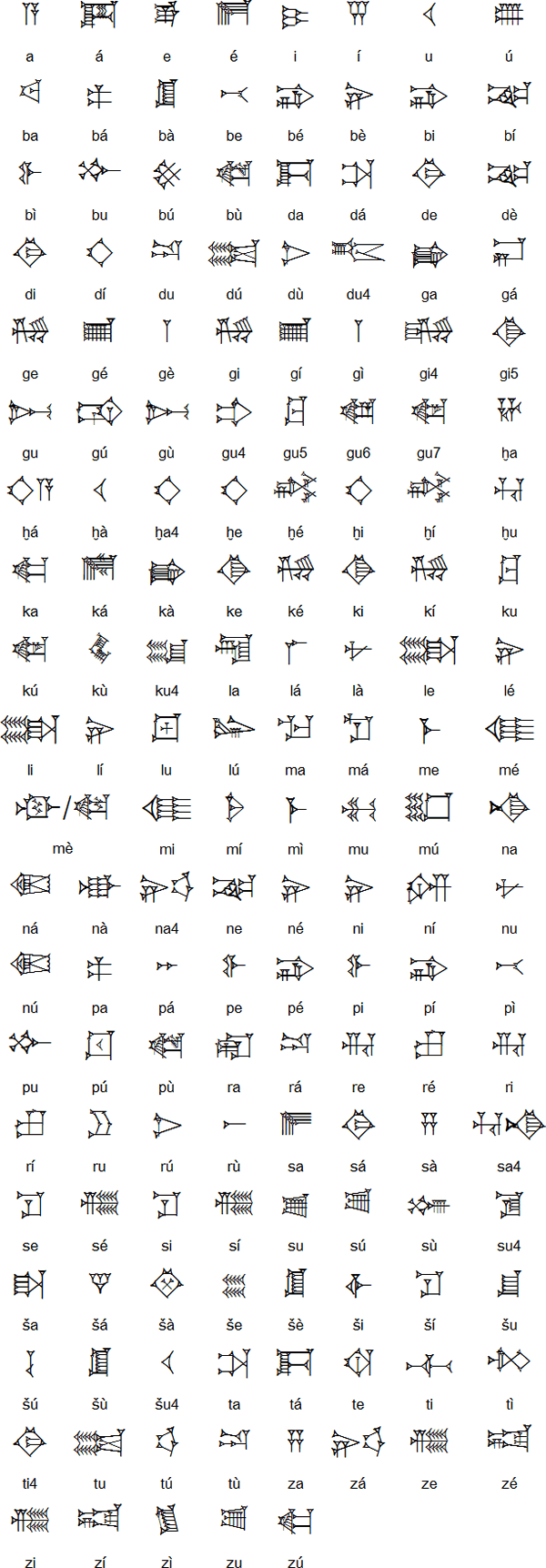
I have a good book demonstrating the evolution but I'd have to dig it up.
Anyway vinca's sort of a moot point because we cant compare phonetics associated with symbols... it would be really amazing to discover what language / group they spoke!
Yeah I know vinca predates Sumerian, hence why I said common origin perhaps. You're wrong, there are only a couple runes in there. Isa, Madr, Gebo, and then a couple similar to Ehwaz, Othilo, one as a stretch could resemble Hagalaz. 3 out of 16 or 24 is not strong enough connection.
Sumerian has a discernible history regardless, where it's been traced from early pictographs developing into the cuneiform:

I have a good book demonstrating the evolution but I'd have to dig it up.
Anyway vinca's sort of a moot point because we cant compare phonetics associated with symbols... it would be really amazing to discover what language / group they spoke!
a reply to: Ridhya
Vinca is not moot IMO as there are origin connections which is relevant to migration and cultural and linguistic formation.
The connections between Neolithic astronomical megalithic cultures is similar throughout many lands and it's origins are perhaps the Vinca of the Carpathian basin, migrating to Europe, Scandinavia, Mediterranean, Asia and beyond.
www.rovasirasforrai.hu...
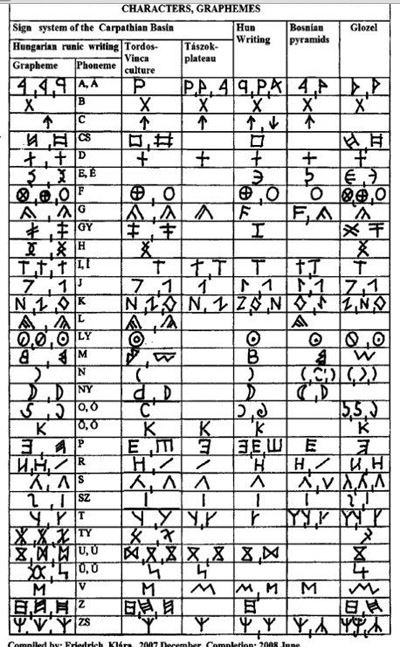
Vinca is not moot IMO as there are origin connections which is relevant to migration and cultural and linguistic formation.
The connections between Neolithic astronomical megalithic cultures is similar throughout many lands and it's origins are perhaps the Vinca of the Carpathian basin, migrating to Europe, Scandinavia, Mediterranean, Asia and beyond.
www.rovasirasforrai.hu...
The ancient origin of the Anglo-Saxon runes in the Tordos-Vinca culture of the Carpathian basin: These cultures flowered 4-5,000 B.C. The Tordos culture was excavated by the afore mentioned Zsófia Torma archaeologist, she collected many signs found on the bottom of clay vessels, clay disks. These signs we can study in Winn's book which is mentioned in professional literature. The signs of the Tordos-Vinca culture life continues in the Scythian-Hun-Avar-Magyar rovás (runic writing). The Germanic people adopted these from here, cca. the second century B.C. Several of the Indus-valley script show similarities in form with the letters of the Magyar rovás. In our table you can compare the Magyar rovás and the Tordos-Vinca culture's set of signs.

Vikings sailed to many places and had contact with many different people, they bought things - but also took what they wanted. There is no real way to
know how the ring ended up where it did, only where it possibly came from.
originally posted by: babybunnies
I believe that the timeline of human history and the amount of contact between ancient civilizations has either been massively under estimated or we've been lied to a LOT by the archealogical community.
I think there is a MASSIVE cover up going on in archaeology circles regarding the true human timeline. There are just too many items being uncovered that don't match the officially accepted timelines, such as 17,000 year old cities when we were supposed to be living in caves until 12,000 years ago.
ikr... I'm getting to the point that unless my grandparents actually saw it happen... then it's only a story that somehow benefits people we will never meet.
a reply to: theabsolutetruth
Super interesting stuff, keep it coming.
Do you have any past threads dealing with this? Or if not, maybe a few good links?
Super interesting stuff, keep it coming.
Do you have any past threads dealing with this? Or if not, maybe a few good links?
a reply to: Spider879
I dont know why people are surprised, most societies in everything are intertwined in many ways even in ancient ancient pasts, so much so is why we get the same old rehashes and myths all in different clothing. Besides the viking got around, I mean really wherever they could go, they went. So no surprise there. And today its pretty much the same thing, even in social media context.
But ya the 13th warrior was an awesome movie.
I dont know why people are surprised, most societies in everything are intertwined in many ways even in ancient ancient pasts, so much so is why we get the same old rehashes and myths all in different clothing. Besides the viking got around, I mean really wherever they could go, they went. So no surprise there. And today its pretty much the same thing, even in social media context.
But ya the 13th warrior was an awesome movie.
a reply to: galadofwarthethird
Yes folks will show-up in other places one couldn't even dream they could ever be, people will pack a bag a simply travel sometimes in small groups or individuals some of them even had an impact on the societies they visited or settled.
Yes folks will show-up in other places one couldn't even dream they could ever be, people will pack a bag a simply travel sometimes in small groups or individuals some of them even had an impact on the societies they visited or settled.
new topics
-
Planned Civil War In Britain May Be Triggered Soon
Social Issues and Civil Unrest: 28 minutes ago -
Claim: General Mark Milley Approved Heat and Sound Directed Energy Weapons During 2020 Riots
Whistle Blowers and Leaked Documents: 2 hours ago
top topics
-
Claim: General Mark Milley Approved Heat and Sound Directed Energy Weapons During 2020 Riots
Whistle Blowers and Leaked Documents: 2 hours ago, 3 flags -
Planned Civil War In Britain May Be Triggered Soon
Social Issues and Civil Unrest: 28 minutes ago, 1 flags
active topics
-
Ukraine halts transit of Russian gas to Europe after a prewar deal expired
Political Conspiracies • 145 • : Oldcarpy2 -
Sorry to disappoint you but...
US Political Madness • 37 • : matafuchs -
The Truth about Migrant Crime in Britain.
Social Issues and Civil Unrest • 24 • : angelchemuel -
Claim: General Mark Milley Approved Heat and Sound Directed Energy Weapons During 2020 Riots
Whistle Blowers and Leaked Documents • 7 • : fringeofthefringe -
Gravitic Propulsion--What IF the US and China Really Have it?
General Conspiracies • 25 • : Lazy88 -
Trudeau Resigns! Breaking
Mainstream News • 69 • : KrustyKrab -
Planned Civil War In Britain May Be Triggered Soon
Social Issues and Civil Unrest • 0 • : TimBurr -
Stuck Farmer And His Queue Jumping Spawn
Rant • 10 • : Cvastar -
Joe Biden gives the USA's Highest Civilian Honor Award to Hillary Clinton and George Soros.
US Political Madness • 59 • : mysterioustranger -
Greatest thing you ever got, or bought?
General Chit Chat • 24 • : mysterioustranger
